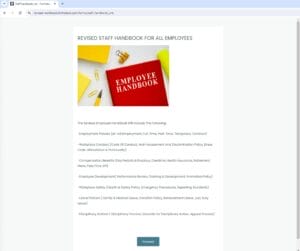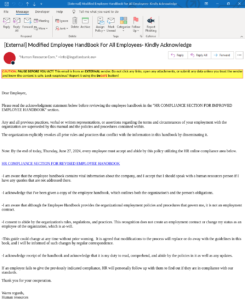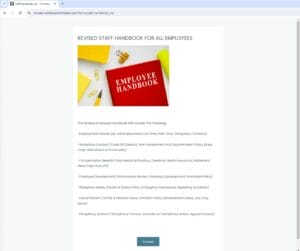
2024-7-16 00:43:6 Author: securityboulevard.com(查看原文) 阅读量:3 收藏
Found in Environments Protected By: Google, Outlook 365, Proofpoint
By Sabi Kiss, Cofense Phishing Defense Center
Phishing attacks are becoming increasingly sophisticated, and the latest attack strategy targeting employees highlights this evolution. In this blog post, we’ll dissect a recent phishing attempt that impersonates a company’s Human Resources (HR) department, and we’ll provide detailed insights to help you recognize and avoid falling victim to such scams.
This phishing email is designed to look like an official communication from your company’s HR department. It arrives in your inbox with a subject line that grabs attention, urging you to review the employee handbook.

Figure 1: Email Body
The email’s layout and language further enhance its perceived legitimacy. It opens with a formal greeting and presents a message in a structured format typical of corporate communications. The language used is professional, clear, and direct, mimicking the tone and style that employees would expect from an HR department.
The subject line, “Modified Employee Handbook For All Employees – Kindly Acknowledge,” immediately grabs attention and creates a sense of urgency. This tactic is designed to provoke quick action from recipients, prompting them to open the email and engage with its contents without hesitation.

Figure 2: Phishing Page
The body of the email includes formal language and directives typical for corporate communications. It begins with a polite greeting and swiftly transitions into a directive to review a revised employee handbook. The email stresses the importance of compliance by a specific deadline, typically by the end of the day, fostering a sense of urgency and importance among recipients.
The primary goal of this phishing email is twofold: to lure recipients into clicking on the embedded hyperlink and to trick them into entering their credentials on a fake login page. By appearing to originate from a trusted source (HR department), the email leverages authority and urgency to persuade recipients to take immediate action without questioning the authenticity of the request.
The threat actor employs psychological tactics such as fear of non-compliance with company policies, and the promise of significant changes outlined in the handbook, to manipulate recipients into clicking on the malicious link. This psychological manipulation aims to override recipients’ natural scepticism and caution when handling unsolicited emails.
The email contains a hyperlink with the heading, “HR COMPLIANCE SECTION FOR REVISED EMPLOYEE HANDBOOK.” Clicking on this link takes you to a page that mimics a legitimate document hosting site. Here, you are presented with a “PROCEED” button to continue.
Upon clicking the “PROCEED” button, you are redirected to a page that appears to be branded by Microsoft. This is where the phishing attack becomes more sophisticated. The page asks for your Microsoft username and looks very convincing.

The threat actor’s strategy is to gain your trust by presenting a legitimate-looking website where you are prompted to log in with your company’s Microsoft credentials. Here’s a detailed breakdown of what happens next:
- Capture of Credentials: When you enter your company email address and press next, you are redirected to what looks like your company’s Microsoft Office 365 login page.
- Error Message: After entering your username and potentially your password, you receive an error message stating, “There was an unexpected internal error. Please try again.” This message is a ruse.
- Redirection to Legitimate Login Page: You are then redirected to your actual company’s SSO/Okta login page, and the victim will likely not even realize the URL changed. In the meantime, the threat actor has captured your username and password from the login attempt.
| Indicators of Compromise | IP |
| hXXps://hresourcinfo[.]henryscchein[.]com/?o4i8h=ZR | 104[.]236[.]9[.]231 |
| hXXps://revised-workbook[.]formstack[.]com/forms/staff_handbook_ynk | 52[.]85[.]132[.]103
52[.]85[.]132[.]32 52[.]85[.]132[.]40 52[.]85[.]132[.]118 |
This phishing campaign exemplifies the growing sophistication of cyber threats that exploit trust and urgency within corporate environments. By mimicking legitimate communications and leveraging psychological manipulation, threat actors attempt to deceive employees into divulging sensitive information. Vigilance and robust cybersecurity measures, including security awareness training and advanced email security solutions, are crucial in mitigating such risks and protecting organizations from falling victim to phishing attacks. Strengthening defenses against phishing requires a multi-layered approach that combines technological solutions with empowered and vigilant employees as the first line of defense.
All third-party trademarks referenced by Cofense whether in logo form, name form or product form, or otherwise, remain the property of their respective holders, and use of these trademarks in no way indicates any relationship between Cofense and the holders of the trademarks. Any observations contained in this blog regarding circumvention of end point protections are based on observations at a point in time based on a specific set of system configurations. Subsequent updates or different configurations may be effective at stopping these or similar threats. Past performance is not indicative of future results.
The Cofense® and PhishMe® names and logos, as well as any other Cofense product or service names or logos displayed on this blog are registered trademarks or trademarks of Cofense Inc.
The post Beware of the Latest Phishing Tactic Targeting Employees appeared first on Cofense.
*** This is a Security Bloggers Network syndicated blog from Cofense authored by Cofense. Read the original post at: https://cofense.com/blog/beware-of-the-latest-phishing-tactic-targeting-employees/
如有侵权请联系:admin#unsafe.sh